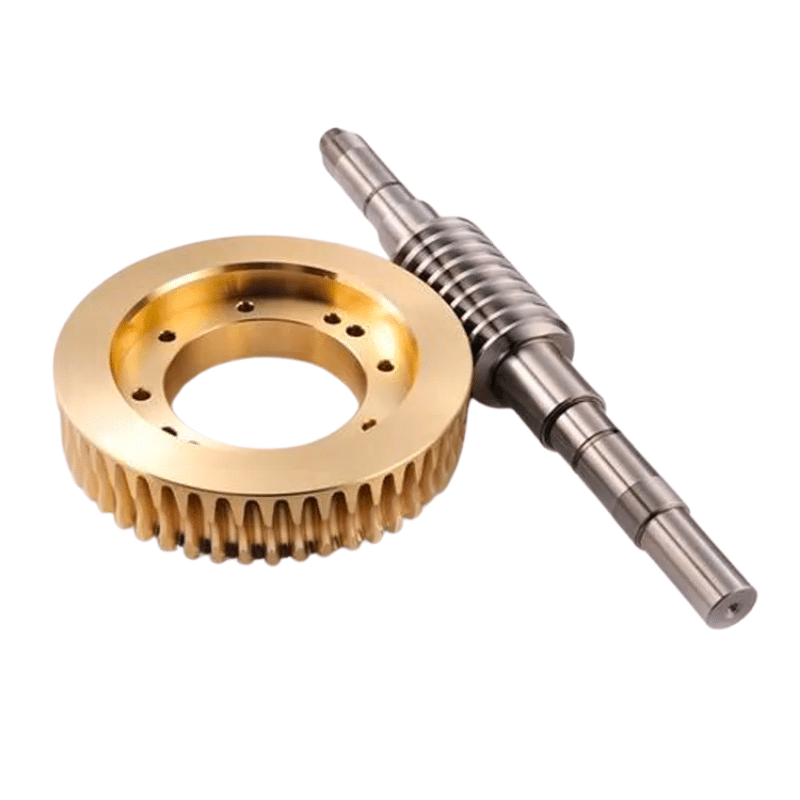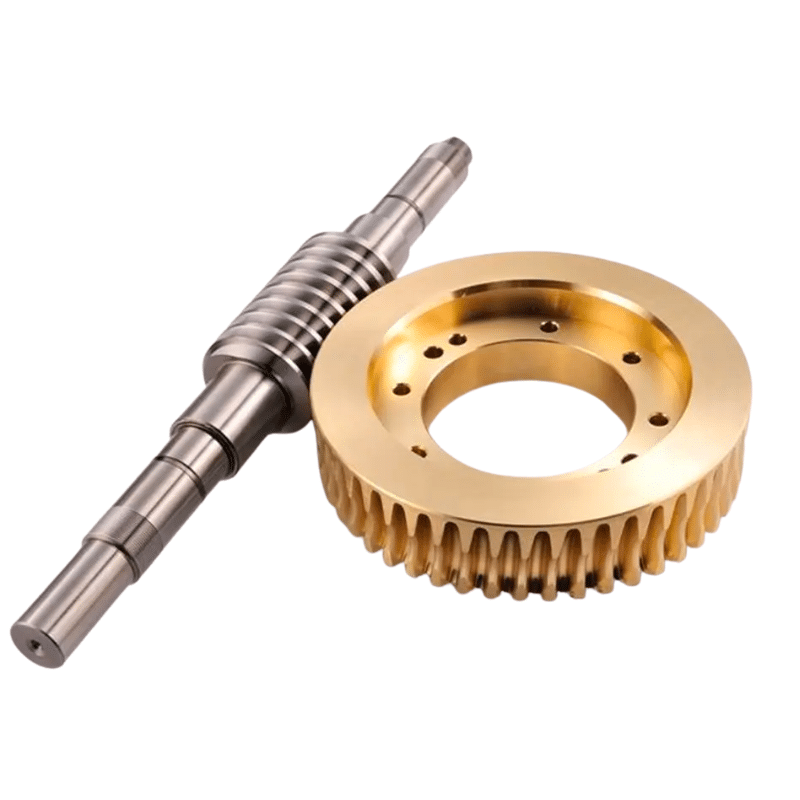Worm Shaft And Worm Gear
Worm Shaft And Worm Gear
Say goodbye to the hassle of frequent lubrication maintenance. Our self-lubricating technology ensures smooth operation and reduces wear and tear, extending the lifespan of your equipment. Experience uninterrupted productivity and cost savings as you bid farewell to the need for messy lubricants and time-consuming upkeep.
Manufacturing on Demand
Worm Shaft And Worm Gear
Worm Shaft and Worm Gear, In the realm of mechanical engineering, the worm shaft and worm gear assembly play a pivotal role in the world of power transmission and machinery. This unique combination is renowned for its efficiency in reducing speed and increasing torque. Here, we delve into the intricacies of these components, exploring their design, operation, applications, and advantages.
Understanding Worm Shaft and Worm Gear: An Integral Component in Modern Machinery, Worm Gear Pairs, electric flipper actuator with shaft and worm gear
A worm gear is a specialized gear type comprising a shaft with a spiral thread that engages with and drives a toothed wheel. The worm, resembling a screw, rotates against the wheel. As it turns, the screw’s surface presses against the wheel’s teeth, which then exert force against the load. This design is effective for significantly increasing torque or reducing speed. Notably, due to the friction between the worm and the wheel, reversing the direction of power transmission is practically impossible.
In terms of materials, worm gears are usually constructed from harder substances compared to worm wheels, to minimize wear. For example, the worm might be made from steel, while the wheel could be crafted from brass or phosphor bronze. Leaded bronze, recognized for its lubricating properties, is frequently used in worm gears, especially when the worms are made from softer, non-hardened steel.
An electric flipper actuator, conversely, is a device that transforms electrical energy into mechanical motion. This type of actuator is versatile, finding use in various settings like pinball machines or in systems requiring the movement of optics in and out of a beam path. Electric actuators facilitate lifting heavier loads with less effort, offering a smooth and efficient alternative without the need for manual charging.
We specialize in producing these components. Our manufacturing range includes phosphor-bronze worm gears, aluminium bronze, and precision gears, particularly focusing on worm gears. Additionally, we provide electric actuators and bronze ring parts. It is essential to understand that our production capabilities are tailored to meet the specific specifications and requirements of the worm gear and electric flipper actuator needed.
Worm shaft and worm gear – What are Worm Shaft and Worm Gear?
A worm gear system consists of two main components: the worm shaft and the worm gear.
- Worm Shaft: The worm shaft is a cylindrical component with a helical thread that resembles a screw. This shaft is the primary driver in the worm gear setup, initiating the motion that drives the gear.
- Worm Gear: The worm gear, in contrast, is a toothed wheel that meshes with the thread of the worm shaft. The gear’s teeth are designed to perfectly align with the helical structure of the shaft.
How Do They Work Together?
The operation of a worm gear and shaft is straightforward yet efficient. As the worm shaft rotates, its threads engage with the teeth of the worm gear. This interaction converts the rotational motion of the shaft into a slower, more powerful rotational motion in the gear. The angle and size of the worm dictate the gear’s speed and torque capabilities.
Worm Shaft and Worm Gear Applications
Worm gears and shafts are ubiquitous in machinery where precise motion control is essential. They are commonly found in:
- Automotive Systems: Steering mechanisms often use worm gears for smooth and responsive control.
- Industrial Machinery: In conveyor systems, worm gears provide the necessary torque and speed control.
- Robotics: Precision and controlled motion are critical in robotics, making worm gears a preferred choice.
- Elevators and Lifts: The self-locking feature of worm gears ensures safety in these applications.
Worm Shaft and Worm Gear Advantages
The worm gear setup offers several advantages:
- High Torque, Low Speed: Ideal for applications requiring a significant decrease in speed with an increase in torque.
- Compact: The arrangement is more compact compared to other gear systems, making it suitable for space-constrained applications.
- Smooth Operation: Worm gears operate smoothly and quietly, a desirable feature in many applications.
- Self-Locking: In some configurations, worm gears provide a self-locking mechanism, enhancing safety in load-bearing applications.
Worm Shaft and Worm Gear Materials and Manufacturing
The choice of materials for worm gears and shafts is critical for their performance and longevity. Common materials include:
- Steel and Brass: Often, the worm is made of hardened steel, while the gear is made of brass, allowing for durability and reduced wear.
- Leaded Bronze: Used for its lubricating properties, especially when paired with softer steel worms.
Challenges and Considerations, Worm Gears
While advantageous, worm gears have their limitations. The friction in the system can lead to lower efficiency compared to other gear types. Additionally, the choice of materials and the precision of manufacturing are crucial to ensure the longevity and effectiveness of the gear system.
The worm shaft and worm gear are integral components in modern machinery, offering unique advantages in power transmission. Their ability to provide high torque at low speed, along with their compact and smooth operation, make them indispensable in various applications. Understanding their functionality and proper application is key to leveraging their benefits in mechanical design and industry.
Worm Shaft and Worm Gear Systems: Compact and Efficient Gear Solutions
The worm gear system, composed of a worm and a worm wheel, represents a highly efficient gear mechanism. Characterized by its cross-axis orientation, this gear system is notably compact, making it an ideal choice for applications where space is at a premium. Worm gear reducers are particularly renowned for their ability to offer high-ratio speed reduction in small packages.
Smooth Operation and Diverse Applications
A key attribute of worm gears is their smooth and quiet operation, provided they are correctly installed and maintained with appropriate lubrication. This makes them suitable for a variety of applications including:
- Industrial Machinery: Used in presses, rolling mills, and conveying engineering.
- Small Engines and Lift Systems: Ideal for lifts, elevators, and small engine mechanisms.
- Specialized Equipment: Employed in mining industry machines, rudders, and even in specific tools like worm drive saws.
Manufacturing Process
The production of worm gears typically involves hobbing, a process using a cutting tool or hob that resembles the worm gear’s mate. The worm itself can be crafted through various methods including turning, hobbing, milling, or grinding, depending on the required precision and application.
Expertise in Worm Gear Manufacturing
At viiplus, we specialize in producing both standard and custom-sized worm gears. Our team, bolstered by years of experience and a comprehensive array of equipment, is adept at delivering gears of exceptional quality and precision.
Being an employee-owned company, our commitment extends beyond just manufacturing. We strive to surpass customer expectations at every phase of the gear production process. For those in need of custom-designed worms and worm gears, viiplus stands as a reliable and expert choice, ensuring products meet exact specifications with the utmost confidence.
Ground Gears
Custom Gears
Pump Gears
Your expert in self-lubricating Bearing
and Bronze alloys – serving globally



